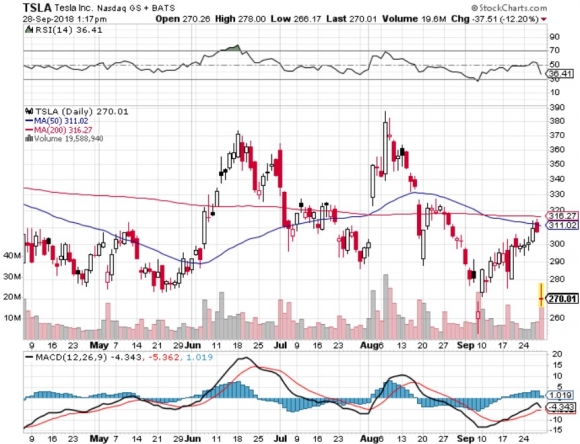As Panasonic ramps up its battery production at the Tesla Gigafactory 1 in Sparks, Nevada, the demand and business for renewable energy has never been more robust.
And as the world’s population balloons and man-made pollutants roil the natural ecosphere, business needs an answer to these potential apocalyptic bombshells or there will be nowhere clean enough to live.
Energy security and population growth will have a complicated relationship going forward and cannot be ignored for the sake of mankind.
This isn’t me being a tree-hugging, Birkenstock-trotting, save-the-earth, love and peace-type of guy.
This problem is real and whoever discovers the solution could reap untold profits.
The answer has been found - rechargeable zinc air batteries.
Spearheading this massive initiative is South African-born entrepreneur, sports team owner, Los Angeles Times owner, and more importantly the founder, chairman and CEO of NantEnergy Dr. Patrick Soon-Shiong.
This El Segundo, California-based company presented an utter game changer to the future of the world and the world’s economy.
NantEnergy debuted a rechargeable battery powered by oxidizing zinc with oxygen from the air for commercial use at the One Planet Summit in New York.
It also has the capability to store energy.
Not only is this technology and product cutting edge, but it has the cost basis to support broad-based scalability and adoption.
Ramkumar Krishnan, chief technology officer of NantEnergy claimed this revolutionary battery can “deliver energy for $100 per kilowatt-hour (kWh).”
Lithium-ion batteries have been the mainstay choice for clean energy or clean enough energy since 1992, and its usage varies in cost from $300 to $500 kWh.
Tesla, with its phalanx of superior engineers, has been able to suppress that cost all the way down to a level between $100 to $200 kWh level.
NantEnergy has already registered more than100 related patents in its name and envisions a $50 billion addressable market.
I believe the addressable market is substantially bigger.
For all the hoopla about lithium-ion batteries, there are severe drawbacks in its usage and application.
Let’s concisely run down the pitfalls of batteries of this ilk.
Once out the factory door, the performance starts to go downhill.
Lithium-ion batteries react poorly to high temperatures.
These batteries become inoperable if completely discharged.
There is a slight chance a battery could burst into flames and burn off your face.
Simply put, lithium-ion batteries incorporate cobalt, an extremely toxic material hazardous to human health.
If a Samsung Galaxy smartphone explodes, cover your mouth to avoid inhaling the cobalt-laced fumes.
Dr. Soon-Shiong characterized this new technology as the “holy grail” of renewable energy.
Wide-scale adoption would bring the need for cobalt to its knees.
No longer would tech companies need to scramble to secure a sufficient amount of cobalt supply from the deepest reaches of the Congo jungle.
It would be the end of cobalt as we know it.
At first, lithium would be required for a stopgap measure while engineers refine the battery on its way to a full-fledged zinc alone battery.
The lithium placeholder would only be temporary.
The clean energy movement must be grinning widely as the potential to finally do away with cobalt from renewable energy has pronounced social and economic consequences.
An estimated 1.4 billion people still live in the dark and do not have access to electricity.
This technology is being tested in villages in Africa and desolate communities in Asia as we speak.
The absence of electricity isolates these undeveloped communities in third-world Africa and Asia without access to health care, education, and technology.
It’s hard to kick-start your life as a sprouting little kid when you’re lost in the dark half the time.
Importing fossil fuel to put these communities online is unfeasible and just plain too expensive for communities that have a dire shortage of capital.
Currently, NantEnergy’s rechargeable zinc air batteries are online in 110 villages located in nine Asian and African countries.
The batteries have been combined to establish a microgrid system powering entire areas.
The company will start delivery this product next year widening its type of use to telecommunications towers.
The next step after that would be the home energy storage market targeting California and New York as the first American cities.
Engineers have pointed out that this development could transform the electric grid into a “round-the-clock carbon-free system.”
In addition, with cooperation with Duke Energy, a major utility, NantEnergy’s batteries have been powering communications towers in America for the past six years.
The design is mind-boggling utilitarian - plastic, a circuit board, and zinc oxide wrapped up in a briefcase-size shell.
One charge can offer 72 hours of battery life.
The charging process is easy - electricity from solar installations is stored by converting zinc oxide to zinc and oxygen.
The discharge process is straightforward, too - the system produces energy by oxidizing the zinc with air.
The pursuit of energy reduction is in full throttle, and this is the next leg up for energy aficionados.
Your lithium-ion-run Tesla could become a legacy company in a matter of years if this technology disrupts Elon Musk’s brainchild.
Lately, Musk has been falling behind the eight ball with fresh innovators hot on his heels.
This is the latest company to enter into its market even though still in the incubation stage.
Competitors have popped out of nowhere and are coming for his bacon.
Shanghai headquartered electric car manufacturer Nio (NIO) went public and raised more than $2 billion.
Even though it is not yet a threat to Tesla, it shows that Tesla isn’t the only game in town anymore.
In any case, NantEnergy has the magic to unlock the “holy grail” of renewable energy. And if it can promise on its cost projections, I see no reason why this won’t be furiously adopted by corporations worldwide.
As it is, America has been losing out in the Congo, as China has cornered the cobalt market there.
And, as the evolution of fracking technology quelled the Middle-East situation, it could also have the same effect in the Congo.
More excitingly, it could put online an additional 1.2 billion new customers to devour iPhones and watch Netflix (NFLX).
Companies such as Facebook (FB) and Alphabet (GOOGL) have been developing a way for these remote and poverty-prone places to use Internet from a satellite.
They would need electricity first to power their devices unless Mark Zuckerberg has found a way to use a smartphone without electricity.
NantEnergy’s renewable batteries have already cut the need of 1 million lithium-ion batteries, and warded off the need to release 50,000 metric tons of carbon dioxide since 2012.
California is the flag-bearer in renewable energy policy by forcing its populace to be at 100% carbon-free electricity by 2045.
Musk is on record by saying he expects to break the 100-kWh level, which would contribute to better power storage and expedited electric vehicle (EV) adoption.
In contrast, energy storage analyst Mitalee Gupta at GTM Research has retorted that he’s “unsure $100/kWh is achievable this year.”
Musk, being a naturally optimistic entrepreneur, sets targets then does everything he can to break them.
Either way, two South African born visionaries are doing their part to crater the cost per kWh in the renewable energy market, and Elon Musk might not be the biggest disruptor from South Africa.
Time will tell if this market will become zinc-based or lithium-based – the higher-grade technology eventually wins out spelling doom for Musk.
But it appears that Musk has other things to worry about now.
NantEnergy plans to inaugurate a battery manufacturing facility in California next year.
As for Tesla, buy the car and not the stock.
And for Nio, don’t buy the car or the stock.

Disrupting the Disrupter






